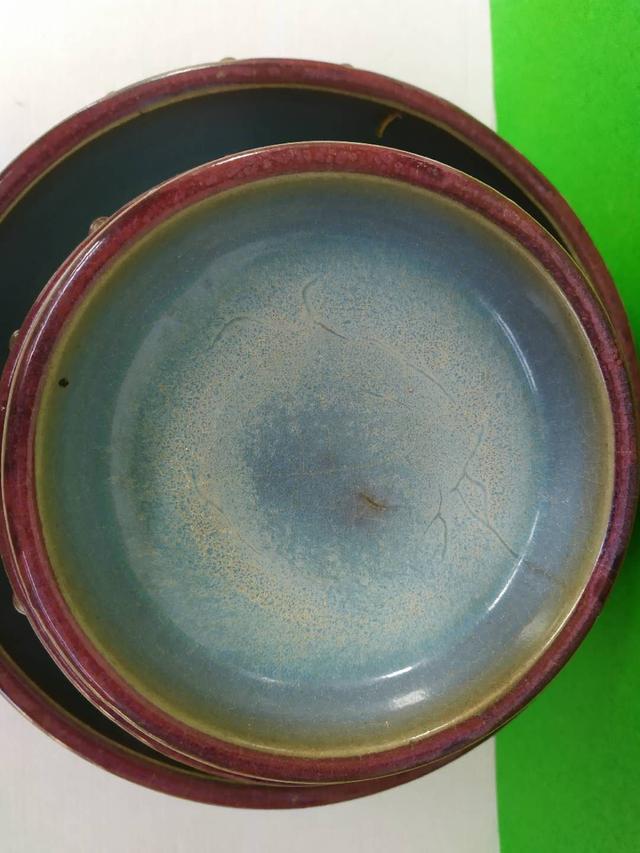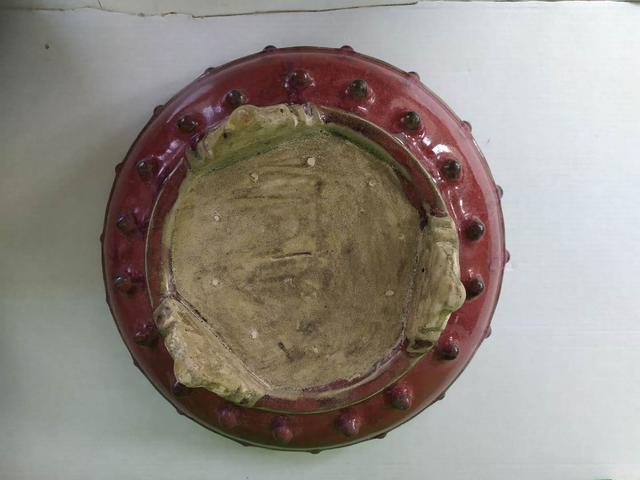【 入窑一色 出窑万彩——钧窑 】
微信号:qinglan337
添加微信好友, 获取更多信息
复制微信号晕如雨后霁霞红, 出火还加微炙工。 世上朱砂非所拟, 西方宝石致难同。 ——乾隆·赏钧红 钧瓷起源 钧窑在河南禹县,始于唐盛于宋,至今已有一千三百多年历史。 钧窑出品的钧瓷胎质坚固敦实,造型端庄典雅,釉色艳丽绝伦,气韵含蓄凝重,被人们称之为“国之
钧瓷是中国宋代的五大名窑之一钧窑出产的瓷器,因宋徽宗时期曾在近禹州市内古钧台附近设置官窑专门烧制御用瓷而得名。钧瓷主要贡献在于烧制成艳丽绝伦的红釉钧瓷,从而开创了铜红釉之先河,改变了以前中国高温颜色釉只有黑釉和青釉的局面,开拓了新的艺术境界。
Jun porcelain is one of the five famous kilns in the Song Dynasty. It was named after the official kilns set up near the ancient Juntai in the city of Yuzhou during the period of Huizong. Jun porcelain's main contribution lies in firing into gorgeous red glaze Jun porcelain, thus creating a precedent of copper red glaze, changing the situation that only black glaze and blue glaze were used in high temperature color glaze in China before, and opening up a new artistic realm.

海棠红的钧瓷在光泽上属非金属的范畴,不同的色调在光泽上可能会有差异,但这种差异性很小,甚至几平觉察不到。从乳光釉上看,海棠红釉内浊釉黏度大,不易流动,所以形成了乳浊釉,从其光泽上看显然应该是不透明的乳光釉,光泽润泽从油性感觉上看,海棠红的钧瓷在光泽上油脂感比较明显,釉质较为鲜嫩。在明暗上海棠红的钧瓷在受光面上是鲜亮的,在明暗结合处淡定柔和,光泽比受光面略逊一些,背光面则表现岀淡雅。钧瓷上的海棠红色彩绚丽,将我们带入一种境界,超越了时间和空间的幻境,这是所见到海棠红钧瓷的每一个人都始料不及的,很自然思绪就会随着视线所能观测到的海棠红色而进入有我或者是无我的境界,会将生活中所有的美好事物,包括心情与此相联,陶冶的是情操,触动的是情怀,感悟到的是人生之美。总之,不同时代的人们,在欣赏钧瓷海棠红的时候会有着各种各样的体会。而这种意境也是鉴定时所要体会的。
Jun porcelain of Begonia red belongs to the category of nonmetal in luster. Different colors may have differences in luster, but the difference is very small, even barely noticed. From the perspective of opalescent glaze, the Opacified Glaze in red Begonia glaze has high viscosity and is not easy to flow, so Opacified Glaze is formed. From the perspective of its luster, it should be opaque opalescent glaze. From the perspective of oil feeling, the oil feeling of Jun porcelain in red Begonia is obvious, and the glaze is fresh and tender. Jun porcelain in bright and dark Shanghai tanghong is bright on the receiving surface, and it is gentle at the combination of light and dark. Its luster is slightly inferior to the receiving surface, and the backlight surface is elegant. The red color of the Begonia on Jun porcelain is gorgeous, which brings us into a state beyond the time and space mirage, which is unexpected for everyone who has seen the red Jun porcelain. It's very natural that the thoughts will enter the state with or without me along with the red color of the Begonia that can be observed in the eyes, and will connect all the good things in life, including the mood, and cultivate them It's sentiment, what we touch is sentiment, and what we realize is the beauty of life. In short, people of different times will have a variety of experiences when appreciating the red Begonia of Jun porcelain. And this kind of artistic conception is also what we should experience in identification

钧瓷以釉色美妙而著称,而他的完美造型更为钧瓷增光添彩,端庄浑厚的造型,简洁明朗的线条,更适于釉子的溢彩流动,经过高温还原气氛,使厚釉出现拉丝、沉积、结晶等变化,呈现出类似兔毛的色线或蚯蚓走泥的痕迹,还有立体感的色点或针尖状的星点,纵横流畅的釉色组成各种奇异的画面,鬼斧神工又自然天成,随着人们丰富的想象而成为各种绝妙的自然景观,如高山云雾、峡谷飞瀑、星辰满天、翠竹生烟、节日礼花、浪激飞舟、令人叹为观止,拍案称奇,堪称国宝。
Jun porcelain is famous for its beautiful glaze color. Its perfect shape adds luster and color to Jun porcelain. It has a dignified and thick shape, simple and clear lines, which is more suitable for the colorful flow of glaze. After high temperature reduction atmosphere, the thick glaze changes in drawing, deposition, crystallization, etc., showing the color line similar to rabbit hair or the trace of earthworm walking mud, as well as the three-dimensional color point or needle like star point, vertical The horizontal and smooth glaze color makes up all kinds of strange pictures. With people's rich imagination, it has become a variety of wonderful natural landscapes, such as mountains and clouds, valleys and waterfalls, stars and sky, green bamboo and smoke, festival flowers, waves and boats. It is amazing, and it is called a national treasure.
许昌:钧瓷文化
常言道:家财万贯,不如钧瓷一片。说的就是钧瓷的珍贵和文化价值。禹州神垕,是中国唯一活着的古镇。神垕,出名瓷。神垕古镇因瓷器而繁荣,瓷器因神垕而名扬天下。 神垕制瓷的历史,早在夏、商时期就有了雏形。神垕的钧瓷是中国五大名瓷之一,入窑一色,出窑

钧瓷从唐宋至今流传 1300年,以绝美的釉色名扬天下,成为中国陶瓷艺术上最灿烂的瑰宝,古人说:赏钧先看釉,钧瓷入窑一色,出窑万彩。经过窑变的钧瓷釉色鲜艳夺目,图案千变万化,美丽至极。钧瓷的釉烧过程极为复杂,难度极高,对温度的控制和烧制的时间都有着非常严格的把握,稍有疏忽,满窑皆废,所以也有十窑九不成的说法,这就是钧瓷为何珍贵的原因!
Jun porcelain has been popular for 1300 years since Tang and Song dynasties. It is famous for its beautiful glaze color, and has become the most brilliant treasure in Chinese ceramic art. The ancients said that Jun porcelain can enjoy the glaze first. Jun porcelain can be used as one color in the kiln and can be used as one color out of the kiln. After the change of the Jun porcelain glaze, the color is bright, the pattern is changeable, and it is extremely beautiful. Jun porcelain's glaze firing process is extremely complex and difficult. It has a very strict grasp of the temperature control and firing time. It is a little careless. All the kilns are abandoned, so there is a saying that ten kilns can't make nine. That's why Jun porcelain is precious!
钧瓷是我国传统文化中的宝贵遗产,尤其北宋后期官钧瓷的制作,无论从造型设计、烧造工艺或品种、釉色、艺术风格、都达到了炉火纯青的地步,以至金元明清各代仿钧之风盛行一时。由于工艺条件和审美的不同,金元以来各地仿钧窑口除继承宋钧的传统工艺,又创烧出一批具有时代特点的新品种。

Jun porcelain is a precious heritage in Chinese traditional culture, especially in the late Northern Song Dynasty, the production of Guan Jun porcelain, no matter from the shape design, firing technology or variety, glaze color, artistic style, has reached the point of perfection, and even the imitation of Jun in the Jin, yuan, Ming and Qing Dynasties prevailed for a while. Because of the difference of technological conditions and aesthetics, since the Jin and Yuan Dynasties, in addition to inheriting the traditional technology of Song Jun, a number of new varieties with the characteristics of the times have been created.

专家推荐:鼓钉洗主要在宋代宋徽宗时期的钧窑有所烧制。流行了一段时间后鼓钉洗造型消失。后来在金、元仿烧较多,至清代雍正七年的时候,仿钧窑比较成功,包括鼓钉洗的造型。钧瓷鼓钉洗鼓钉一个个均匀分布在其身侧,釉色红紫相间,美丽夺目,鼓钉洗内部欣赏,清雅的釉色映衬着经典钧红,既素雅又艳丽,此套笔洗通体满釉,釉层光亮,开片稀疏,内部釉色粉青,造型别致,工艺讲究,此洗既无精美繁复的雕饰,也无艳彩浓抹的图案,器形简简单单但极显古朴端庄,包浆自然沁入胎骨,釉面开片纹,犹如网线纵横交错。彰显古朴,保持完好,为宋代钧瓷之典型作品,整器规整对称,宫廷气势,高雅大气,一丝不苟。釉面温润如玉,极为素雅造型庄重大方。线条清晰有致优美流畅,繁而不乱,工艺精湛,保存完好实属难得,极具收藏和考研价值。
Experts recommend that: the drum nail washing was mainly made in Jun kiln during the period of Huizong in Song Dynasty. After a period of popularity, the shape of drum nail washing disappeared. Later, there were many imitations in Jin and Yuan Dynasties. By the seventh year of Yongzheng in Qing Dynasty, the imitations of Jun kiln were more successful, including the shape of drum and nail washing. Jun porcelain drum nail washing drum nails are evenly distributed on the side of the body one by one. The glaze is red and purple, beautiful and eye-catching. The inside of the drum nail washing is appreciated. The elegant glaze reflects the classic Jun red, which is both elegant and gorgeous. This set of brush washing is full of glazes, with bright glaze layer, sparse opening, blue internal glaze color, unique modeling and exquisite technology. This washing has neither exquisite and complicated carving nor colorful and concentrated patterns Its shape is simple but very simple and dignified. It's natural to get into the fetal bone, and its glaze is carved like a crisscross net. It is a typical work of Jun porcelain in Song Dynasty. The whole ware is regular and symmetrical. It is elegant and meticulous. The glaze is as warm as jade, which is very elegant and dignified. The lines are clear, beautiful and smooth, complicated but not disordered, the craftsmanship is exquisite, and it is rare to keep them in good condition, which is of great value for collection and postgraduate examination.
本文源自头条号:晒宝交易古玩圈如有侵权请联系删除
【了解】晋家钧窑 :带你去看钧瓷
克利夫兰美术馆,英文简称CMA,成立于1913年,是美国著名的综合性艺术博物馆,也是俄亥俄州东北部的主要公共文化机构之一。其亚洲艺术品是其较为重要、全面的陈列,并以收藏中国书画及瓷器、雕像文物而闻名。 以下图片来自克利夫兰美术馆官网,已开放版权CC(

- 本文固定链接: http://junciba.com/?id=177
- 转载请注明: 钧瓷老六 于 钧瓷吧 发表
